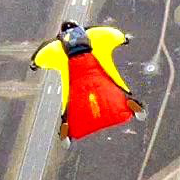
Was: Recommended specs on reserve exit weight, do you go over max?
By
phoenixlpr, in Gear and Rigging
Recommended Posts
But just from reading your post I would guess that a 150 anything is too small for you to be on.
imstu 0
QuoteJumping canopies that are seriously out of trim can result in funky openings.
I will not jump those two canopies again until they are relined (I have a few canopies). I'm stupid, but not suicidal.Quote
That's for sure! I found that out the hard way. I didn't know how far out of trim they were until after the two bad openings.
***Why not get the canopies relined if they're out of trim?The Stiletto 170 I'm jumping now is a newer one. It has less than 200 jumps on it and my rigger is checking the lines on it just to be sure. The older Stiletto 170 and 150 are going back to PD to be relined.
Thank you for the input, Bob.
Stuart
imstu 0
Admittedly, the 150 was too small for me. I was jumping alot at the time and thought I could handle it. I didn't have any problems with it, but I can see where it was a bit much for me. I would like to stay with the 170 for a while and learn to fly it to it's potential. I really like how it flies! I'm going to get the older 170 relined so I will have two rigs with the same canopies in them like I did with the Sabre 190s. I still jump a 190 when I first get to a new dropzone or it's been a while since I last jumped. Then I jump the 170. I stand up my landings and land where I set out to land. I did ask my old instructor about jumping the 170 and he OK'd it before I started on it. I haven't had any trouble flying or landing the canopies, just surviving the openings. I would like to learn as much as possible about opening sequence and what affects it. Thank you for any input you can give me.QuoteWith out knowing more about you (fill in your profile) I would not attempt to offer any advice.
But just from reading your post I would guess that a 150 anything is too small for you to be on.QuoteI'm sorry about that Sparky. I filled in my Profile.
Stuart
br0k3n 0
--+ There are 10 types of people in the world: Those who understand binary, and those who don't.. --+
AceJack 0
I am new to this forum and this is my first post. I've been reading this thread and can't help but to chime in. Although I am a layman to this subject and new to the sport I actually agree with Phoenix and think what he have to say have merit. I totally believe that airspeed have more affect on peak loads than weight. I don't have any fancy mathematical formula but if you look at this problem from another perspective, you may see that what he says might be true. Example: You take a heavy guy and he deploys his large 'chute at a certain speed. You will get a X number of force as he decelerate. Now you take the same guy and have him deploy a much smaller (overloaded) 'chute at the same airspeed you should not get more force. In fact, you should get less force due to less drag from the smaller 'chute. Yes, the smaller canopy will fall somewhat faster for a longer period of time, this should not cause the canopy to blow up because you are well within the design parameter (airspeed) of that canopy. Remember, the forces generated here is not the same as if you tie a weight to a fixed object and drop it. With that said, I am assuming that the smaller 'chute is made with the same construction techniques and material as the bigger chute and of the same strength. I am also assuming the two 'chutes have similar opening speed as each other. I know that is a lot to assume but I am keeping those two factors the same for the sake of argument. And as for the max recommended weight on the canopy, I think that has more to do with the sink rate and the speed it would fly when you try to land it.
I know I'm going to catch a lot flak by going against the grain here but I'm here to learn and so far I've learned a lot by reading different opinions.
Me thinks you assume too much.
980 0
QuoteHi all,
I am new to this forum and this is my first post.
way to go on an awesome first post!
Quote
AlthoughBECAUSE I am a layman to this subject and new to the sport I actually agree with Phoenix and think what he have to say have merit.
there, I fixed it for you
QuoteI don't have any fancy mathematical formula
you also have almost no real experience in this matter, so why would you be willing to contradict people that do?
QuoteI am also assuming the two 'chutes have similar opening speed as each other.
wrong
Quoteas for the max recommended weight on the canopy, I think that has more to do with the sink rate and the speed it would fly when you try to land it.
wrong again
QuoteI know I'm going to catch a lot flak by going against the grain here but I'm here to learn and so far I've learned a lot by reading different opinions.
you're not catching flak for going against the grain, you're catching flak for making ridiculous statements with no practical experience or reasonable theory to back them up
if you think you have learned from reading phoenixlpr's (and such, but he's the prime example) opinions, you have a lot to learn about learning
billvon 2,400
>a certain speed. You will get a X number of force as he decelerate.
>Now you take the same guy and have him deploy a much smaller
> (overloaded) 'chute at the same airspeed you should not get more
> force.
Some things you are overlooking:
1) A heavier guy falls faster.
2) A given force will decelerate a small mass quickly, and on a partly elastic system (which a parachute is) the forces peak at a low value. A given force will decelerate a large mass more slowly, and on a partly elastic syste, the forces will peak at a higher value.
>In fact, you should get less force due to less drag from the smaller 'chute.
Parachutes don't work that way. If you open almost any parachute instantaneously at terminal, it will be destroyed, no matter what its size. Reefing (the process of slowing the opening) is required for survivable openings. Some parachutes (like rounds) have some inherent reefing; some require external devices like sliders.
A slider-controlled reefing system is dependent on many things, like jumper weight, deployment airspeed, density altitude etc. So the statement "a smaller parachute gives you less drag during opening" just doesn't make any sense. It's like saying "a smaller car stops faster." The power of the brakes make a much bigger difference than the size of the car.
AceJack 0
I agree that when you apply a force to an object to slow it down. A more massive object would take longer to slow. But, if you were to measure the force to slow an object down, wouldn't the measurement be equivalent to the force opposing the movement not the weight of the object?
Quote: "A heavier guy falls faster." That's why I mentioned that it is the same guy falling at the same speed. Only the size of the canopy is changed. Are the smaller canopy built weaker than the larger ones? I'm still trying to figure that one out.
Like I said before I am inexperienced in this sport. The statement I made before is just a conclusion from I've read from certain posts. It is more of a hypothesis or rather a question to this subject, not facts. Thanks to those who were able to answer some of the questions. To those who just like to say that I'm wrong, maybe it is just easier to pick on the guy who has different opinion and don't have the backing of the general consensus. You still have not provided any explanation to why I'm wrong. You ridicule me on my lack of experience and lack of things to back up what I say, well what real knowledge do you have and what do you have to back up what you say. Like I said, I'm here to learn I'm all ears. BTW why do I go against what everyone has to say? Maybe because at one time everyone thought the world is flat and someone was not afraid to question it.




.thumb.jpg.4bb795e2eaf21b8b300039a5e1ec7f92.jpg)
As to the pilot chute question, I'm afraid I don't have enough knowledge to comment.
Share this post
Link to post
Share on other sites